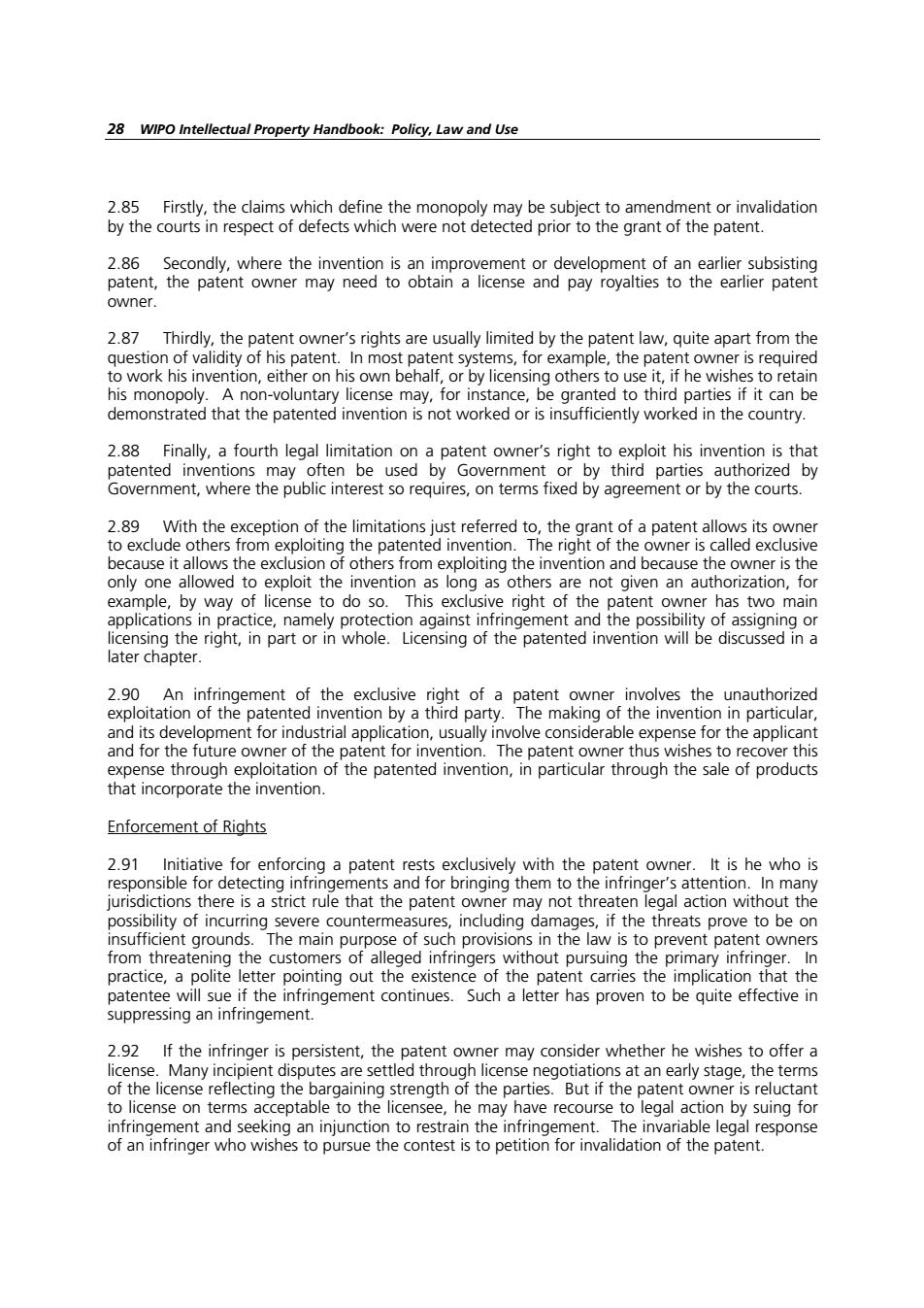
28 WIPO Intellectual Property Handbook:Policy,Law and Use girepratfcation 2.8 ntednteehenyenen5aimprgYEat8argeSyoeomneoi8nerterebegtn own 2 87 Thirdly h estion of validity of his p er on his own behalf,or by licer ing others to use t he wishes 2.88 Finally,a fourth legal imitation on a patent owner's right to ntion is that vement here the publintrsrreotrme y agrement rby te cous 2.89 With th ample.of n a ve right of the tent o has two mair the in p ement and t the later chapter ngem etedhenil strial application,usually involve considerable expense for the applican ure ov that incorporate the invention. Enforcement of Rights 29tuingnnd o ring It is he who is ty of severe countermeasures, ges,if the threats prove to be on ingeet the patentee wi Uppressinga the intrngement continues.Such a letter has proven to be quite enective in 2.92 f the is persistent,the patent owner may consider whether he wishes to offer a to license on ter s a ceptable to the licens ahfmeYn ave recourse to egal a ion by suing to st is t
28 WIPO Intellectual Property Handbook: Policy, Law and Use 2.85 Firstly, the claims which define the monopoly may be subject to amendment or invalidation by the courts in respect of defects which were not detected prior to the grant of the patent. 2.86 Secondly, where the invention is an improvement or development of an earlier subsisting patent, the patent owner may need to obtain a license and pay royalties to the earlier patent owner. 2.87 Thirdly, the patent owner’s rights are usually limited by the patent law, quite apart from the question of validity of his patent. In most patent systems, for example, the patent owner is required to work his invention, either on his own behalf, or by licensing others to use it, if he wishes to retain his monopoly. A non-voluntary license may, for instance, be granted to third parties if it can be demonstrated that the patented invention is not worked or is insufficiently worked in the country. 2.88 Finally, a fourth legal limitation on a patent owner’s right to exploit his invention is that patented inventions may often be used by Government or by third parties authorized by Government, where the public interest so requires, on terms fixed by agreement or by the courts. 2.89 With the exception of the limitations just referred to, the grant of a patent allows its owner to exclude others from exploiting the patented invention. The right of the owner is called exclusive because it allows the exclusion of others from exploiting the invention and because the owner is the only one allowed to exploit the invention as long as others are not given an authorization, for example, by way of license to do so. This exclusive right of the patent owner has two main applications in practice, namely protection against infringement and the possibility of assigning or licensing the right, in part or in whole. Licensing of the patented invention will be discussed in a later chapter. 2.90 An infringement of the exclusive right of a patent owner involves the unauthorized exploitation of the patented invention by a third party. The making of the invention in particular, and its development for industrial application, usually involve considerable expense for the applicant and for the future owner of the patent for invention. The patent owner thus wishes to recover this expense through exploitation of the patented invention, in particular through the sale of products that incorporate the invention. Enforcement of Rights 2.91 Initiative for enforcing a patent rests exclusively with the patent owner. It is he who is responsible for detecting infringements and for bringing them to the infringer’s attention. In many jurisdictions there is a strict rule that the patent owner may not threaten legal action without the possibility of incurring severe countermeasures, including damages, if the threats prove to be on insufficient grounds. The main purpose of such provisions in the law is to prevent patent owners from threatening the customers of alleged infringers without pursuing the primary infringer. In practice, a polite letter pointing out the existence of the patent carries the implication that the patentee will sue if the infringement continues. Such a letter has proven to be quite effective in suppressing an infringement. 2.92 If the infringer is persistent, the patent owner may consider whether he wishes to offer a license. Many incipient disputes are settled through license negotiations at an early stage, the terms of the license reflecting the bargaining strength of the parties. But if the patent owner is reluctant to license on terms acceptable to the licensee, he may have recourse to legal action by suing for infringement and seeking an injunction to restrain the infringement. The invariable legal response of an infringer who wishes to pursue the contest is to petition for invalidation of the patent
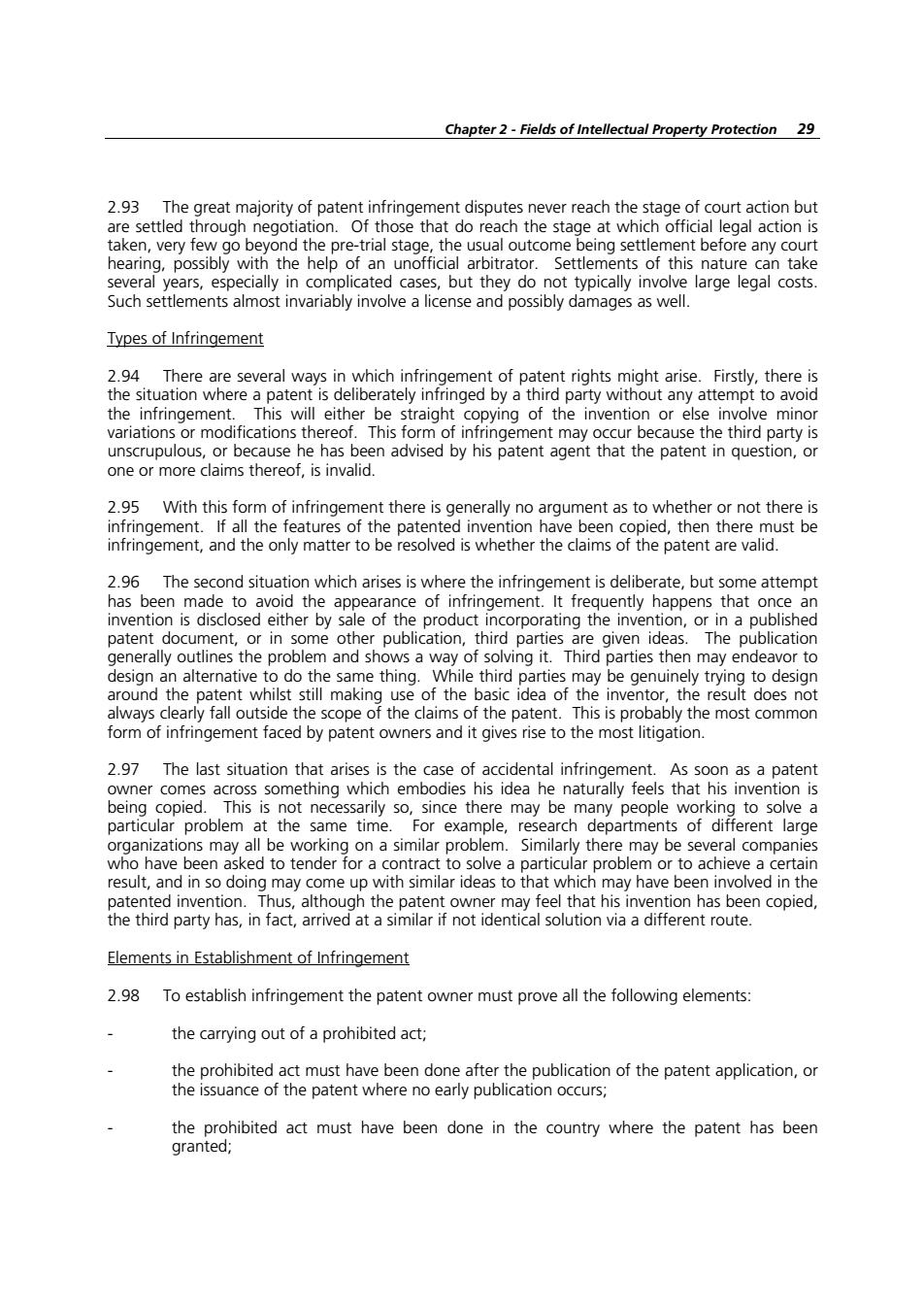
Chapter 2-Fields of Intellectual Property Protection 29 of th nt before any cour nearing, plicated case but the do not ically e large legal cost Such settlements almost invariably involve a license and possibly damages as well. Types of Infringement the infringement. This will either be straigh variations o ment may our eoRnse d0 in question,c ns thereof,is invalid. 295 With this fo 、f infr neoentethereisnereyoarenentna5otowhetherorenotthete5 infringement,and the only matter to be resolved is whether the claims of the patent are valid. 2 96 The second situation which arises is w the infringement is deliberate but so has been made to avoid the appearance of infringement.It freg e product generally outlines the problem and shows a wa of solving it.Third parties then may endeavor to designan he same thing.While third p a be genuinely trying to design nost common form of infringement faced by patent owners and it gives rise to the most litigation. 2.97 The last situation that arises is the case of accidental infringement.as soon as a patent ss something which embodies his idea he naturally feels that his invention is S0, the ts difo to organizations may all be working on a similar problem.Similarly there may be several companie who have been as ed to tender for a c problem o oachieve a atented inver tion although the patent owner may feel that his in tion has been copi the third party has,in fact,arrived at a similar if not identical solution via a different route. Elements in Establishment of Infringement 2.98 To establish infringement the patent owner must prove all the following elements: the carrying out of a prohibited act; ibited act must have been done in the where the patent has been
Chapter 2 - Fields of Intellectual Property Protection 29 2.93 The great majority of patent infringement disputes never reach the stage of court action but are settled through negotiation. Of those that do reach the stage at which official legal action is taken, very few go beyond the pre-trial stage, the usual outcome being settlement before any court hearing, possibly with the help of an unofficial arbitrator. Settlements of this nature can take several years, especially in complicated cases, but they do not typically involve large legal costs. Such settlements almost invariably involve a license and possibly damages as well. Types of Infringement 2.94 There are several ways in which infringement of patent rights might arise. Firstly, there is the situation where a patent is deliberately infringed by a third party without any attempt to avoid the infringement. This will either be straight copying of the invention or else involve minor variations or modifications thereof. This form of infringement may occur because the third party is unscrupulous, or because he has been advised by his patent agent that the patent in question, or one or more claims thereof, is invalid. 2.95 With this form of infringement there is generally no argument as to whether or not there is infringement. If all the features of the patented invention have been copied, then there must be infringement, and the only matter to be resolved is whether the claims of the patent are valid. 2.96 The second situation which arises is where the infringement is deliberate, but some attempt has been made to avoid the appearance of infringement. It frequently happens that once an invention is disclosed either by sale of the product incorporating the invention, or in a published patent document, or in some other publication, third parties are given ideas. The publication generally outlines the problem and shows a way of solving it. Third parties then may endeavor to design an alternative to do the same thing. While third parties may be genuinely trying to design around the patent whilst still making use of the basic idea of the inventor, the result does not always clearly fall outside the scope of the claims of the patent. This is probably the most common form of infringement faced by patent owners and it gives rise to the most litigation. 2.97 The last situation that arises is the case of accidental infringement. As soon as a patent owner comes across something which embodies his idea he naturally feels that his invention is being copied. This is not necessarily so, since there may be many people working to solve a particular problem at the same time. For example, research departments of different large organizations may all be working on a similar problem. Similarly there may be several companies who have been asked to tender for a contract to solve a particular problem or to achieve a certain result, and in so doing may come up with similar ideas to that which may have been involved in the patented invention. Thus, although the patent owner may feel that his invention has been copied, the third party has, in fact, arrived at a similar if not identical solution via a different route. Elements in Establishment of Infringement 2.98 To establish infringement the patent owner must prove all the following elements: - the carrying out of a prohibited act; - the prohibited act must have been done after the publication of the patent application, or the issuance of the patent where no early publication occurs; - the prohibited act must have been done in the country where the patent has been granted;
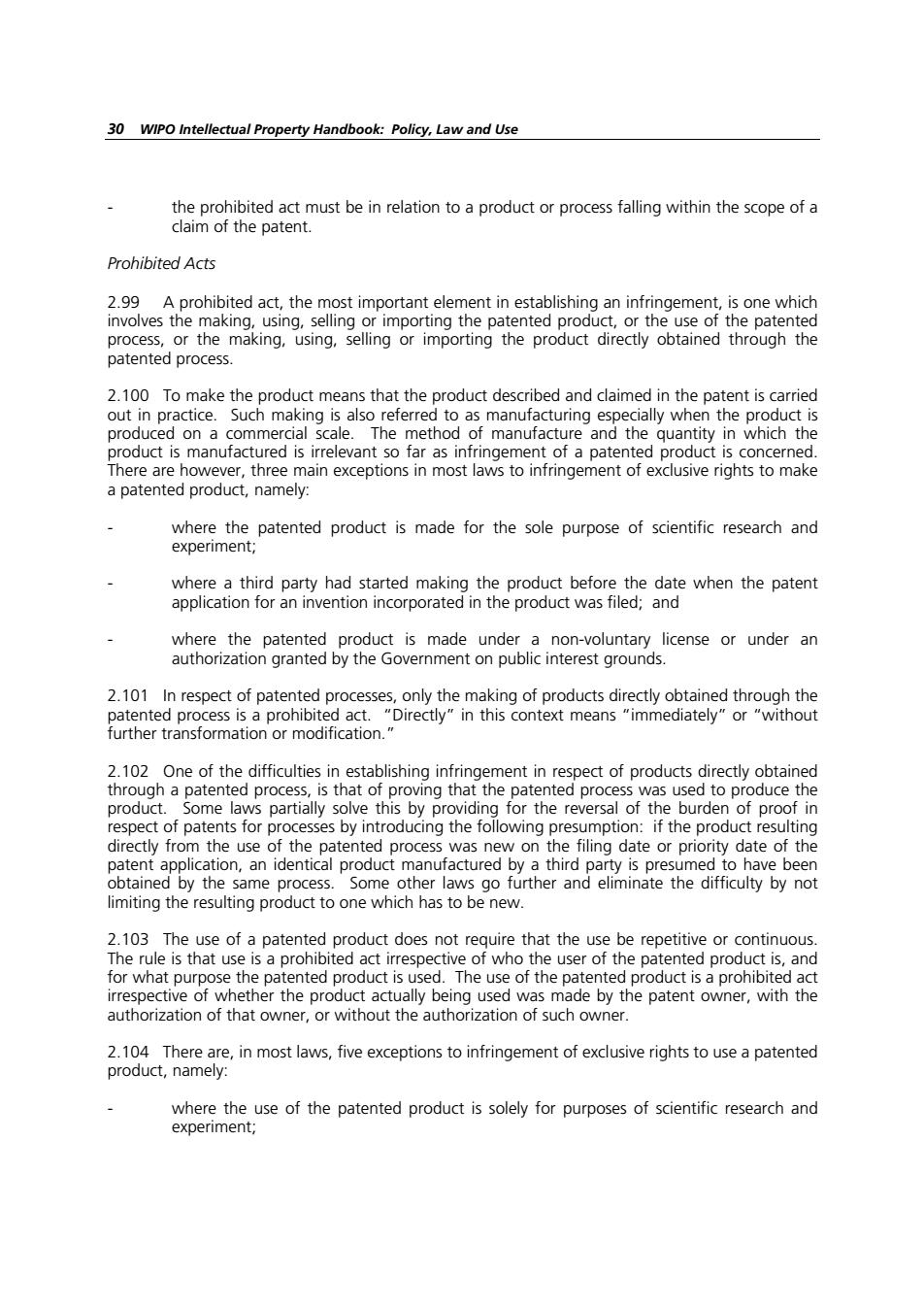
30 WIPO Intellectual Property Handbook:Policy,Law and Use Prohibited Acts 2.99 A prohibited act.the most important element in establishing an infringement.is one which hed through the danddaned produced on a commercial scale.The method of manufacture and the quantity in which the a patented product.namelv: product is made for the purp r and making the prod e when the patent orpor. pate the license or under an 0n9 2.101 In respect of pate further transformation or modification. d c s used to r product 50 me la s partially solve this by providing for the reversal of the burden ot proo directly from the use of the pate ted new on the filing date ty date of th y is presume e bee miting the ifficulty by no or continuous er the product ac mad by the patent owner,with the uch ov .There re inss five exceptionstnofvetapatented product,nan meofthe patented productsel for p of se rerand
30 WIPO Intellectual Property Handbook: Policy, Law and Use - the prohibited act must be in relation to a product or process falling within the scope of a claim of the patent. Prohibited Acts 2.99 A prohibited act, the most important element in establishing an infringement, is one which involves the making, using, selling or importing the patented product, or the use of the patented process, or the making, using, selling or importing the product directly obtained through the patented process. 2.100 To make the product means that the product described and claimed in the patent is carried out in practice. Such making is also referred to as manufacturing especially when the product is produced on a commercial scale. The method of manufacture and the quantity in which the product is manufactured is irrelevant so far as infringement of a patented product is concerned. There are however, three main exceptions in most laws to infringement of exclusive rights to make a patented product, namely: - where the patented product is made for the sole purpose of scientific research and experiment; - where a third party had started making the product before the date when the patent application for an invention incorporated in the product was filed; and - where the patented product is made under a non-voluntary license or under an authorization granted by the Government on public interest grounds. 2.101 In respect of patented processes, only the making of products directly obtained through the patented process is a prohibited act. “Directly” in this context means “immediately” or “without further transformation or modification.” 2.102 One of the difficulties in establishing infringement in respect of products directly obtained through a patented process, is that of proving that the patented process was used to produce the product. Some laws partially solve this by providing for the reversal of the burden of proof in respect of patents for processes by introducing the following presumption: if the product resulting directly from the use of the patented process was new on the filing date or priority date of the patent application, an identical product manufactured by a third party is presumed to have been obtained by the same process. Some other laws go further and eliminate the difficulty by not limiting the resulting product to one which has to be new. 2.103 The use of a patented product does not require that the use be repetitive or continuous. The rule is that use is a prohibited act irrespective of who the user of the patented product is, and for what purpose the patented product is used. The use of the patented product is a prohibited act irrespective of whether the product actually being used was made by the patent owner, with the authorization of that owner, or without the authorization of such owner. 2.104 There are, in most laws, five exceptions to infringement of exclusive rights to use a patented product, namely: - where the use of the patented product is solely for purposes of scientific research and experiment;
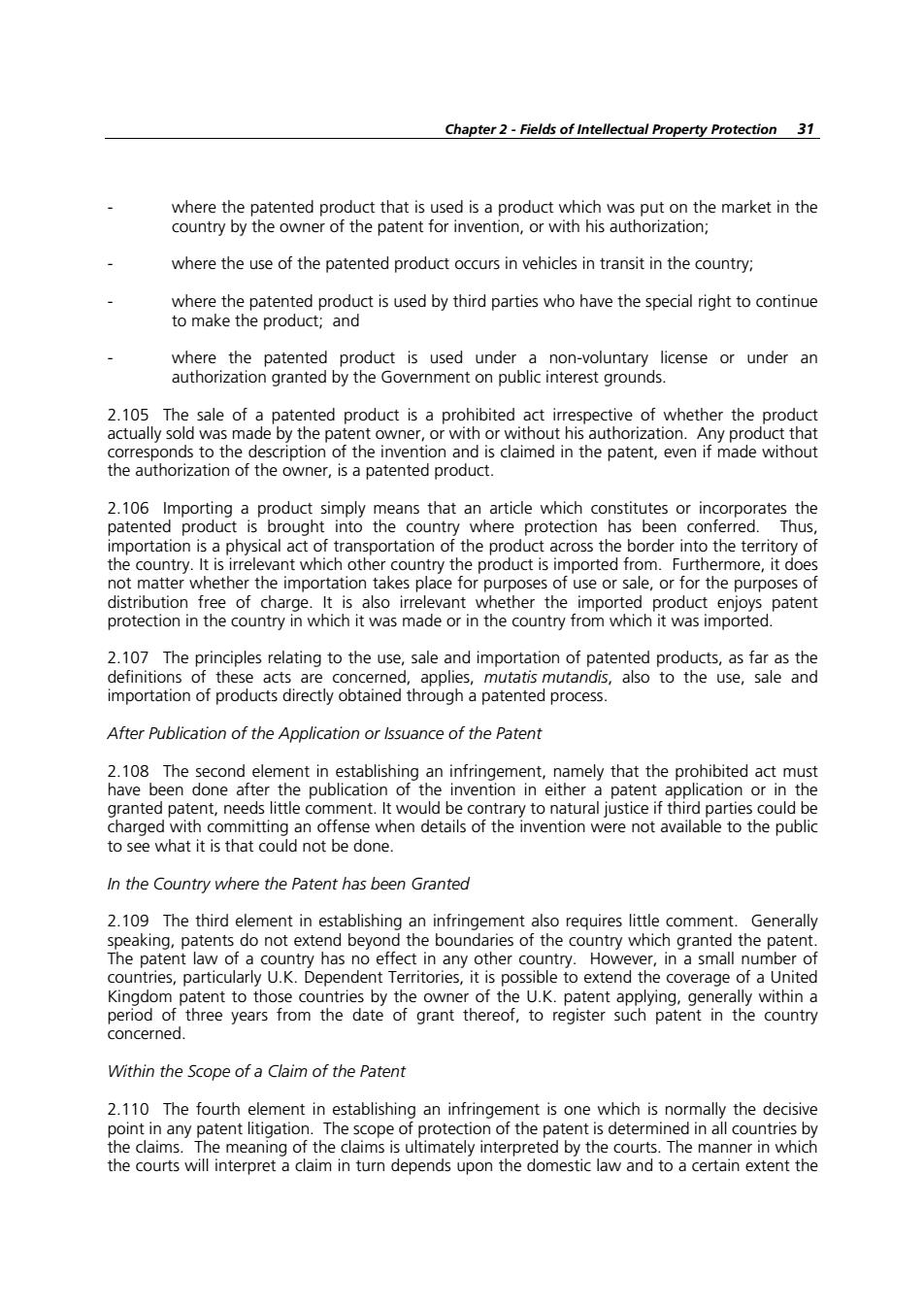
Chapter 2-Fields of Intellectual Property Protection 31 nted where the use of the patented product occurs in vehicles in transit in the country: where the patented product is used by third parties who have the special right to continue to make the product;and where the patented product is used under a non-voluntary license or under an authorization granted by the Government on public interest grounds. 2 105 The sale of a patented product is a rohibited act irrespective of whether the product actually sold was made b the pate rization.Any product that nt,even if made withou is a oduct simply means importation is a physical act of transportation of the product across the border into the territory of rmore,it does It is also irrelevant whether the imno protection in the country in which it was made or in the country from which it wasimpe 2.107 The principles relating to the use,sale and importation of patented products,as far as the detinitions of thes acts are concerr importation o After Publication of the Application or Issuance of the Patent ely that the gangedDatentonetge6oHeeeMegebe,rieYtenaordleetrethigberteiepdbRe to see what it is that could not be done. In the Country where the Patent has been Granted countries,particularly U.K.Dependent Territories,it is possible to extend the coverage of a United of th ee ye日3 concerned. Within the Scope of a Claim of the Patent The in a the courts will interpret a claim in turn depends upon the domestic law and to a certain extent the
Chapter 2 - Fields of Intellectual Property Protection 31 - where the patented product that is used is a product which was put on the market in the country by the owner of the patent for invention, or with his authorization; - where the use of the patented product occurs in vehicles in transit in the country; - where the patented product is used by third parties who have the special right to continue to make the product; and - where the patented product is used under a non-voluntary license or under an authorization granted by the Government on public interest grounds. 2.105 The sale of a patented product is a prohibited act irrespective of whether the product actually sold was made by the patent owner, or with or without his authorization. Any product that corresponds to the description of the invention and is claimed in the patent, even if made without the authorization of the owner, is a patented product. 2.106 Importing a product simply means that an article which constitutes or incorporates the patented product is brought into the country where protection has been conferred. Thus, importation is a physical act of transportation of the product across the border into the territory of the country. It is irrelevant which other country the product is imported from. Furthermore, it does not matter whether the importation takes place for purposes of use or sale, or for the purposes of distribution free of charge. It is also irrelevant whether the imported product enjoys patent protection in the country in which it was made or in the country from which it was imported. 2.107 The principles relating to the use, sale and importation of patented products, as far as the definitions of these acts are concerned, applies, mutatis mutandis, also to the use, sale and importation of products directly obtained through a patented process. After Publication of the Application or Issuance of the Patent 2.108 The second element in establishing an infringement, namely that the prohibited act must have been done after the publication of the invention in either a patent application or in the granted patent, needs little comment. It would be contrary to natural justice if third parties could be charged with committing an offense when details of the invention were not available to the public to see what it is that could not be done. In the Country where the Patent has been Granted 2.109 The third element in establishing an infringement also requires little comment. Generally speaking, patents do not extend beyond the boundaries of the country which granted the patent. The patent law of a country has no effect in any other country. However, in a small number of countries, particularly U.K. Dependent Territories, it is possible to extend the coverage of a United Kingdom patent to those countries by the owner of the U.K. patent applying, generally within a period of three years from the date of grant thereof, to register such patent in the country concerned. Within the Scope of a Claim of the Patent 2.110 The fourth element in establishing an infringement is one which is normally the decisive point in any patent litigation. The scope of protection of the patent is determined in all countries by the claims. The meaning of the claims is ultimately interpreted by the courts. The manner in which the courts will interpret a claim in turn depends upon the domestic law and to a certain extent the
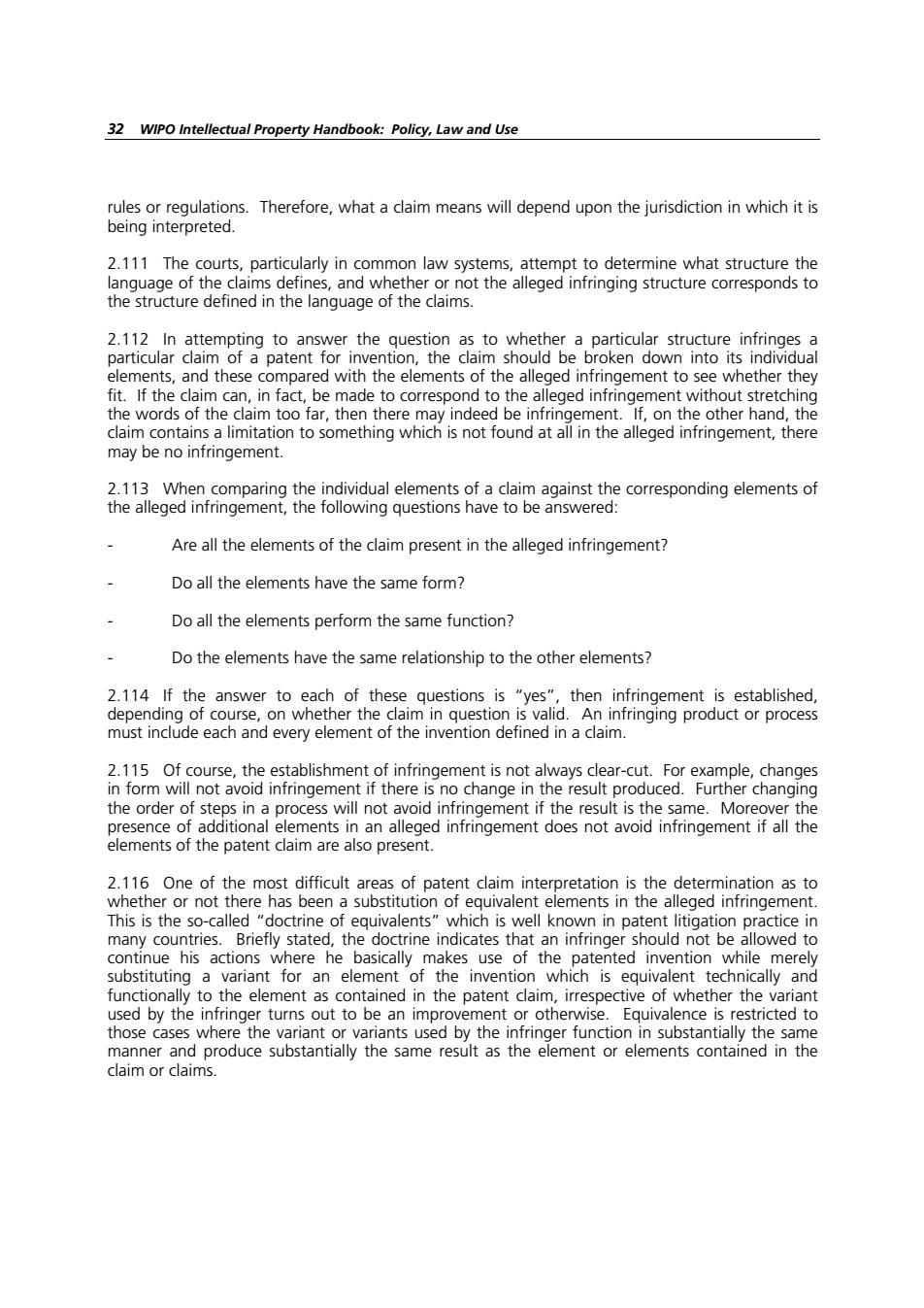
32 WIPO Intellectual Property Handbook:Policy,Law and Use the structure defined in the language of the claims. nd thesellegedingmnt to see whethe claim contains a limitation to something which is not found at all in the alleged infringement,there may be no infringement. 子11ggmgo2the8oiddaRhebeg9eorepondngeonenso叶 Are all the elements of the claim present in the alleged infringement? Do all the elements have the same form? Do all the elements perform the same function? Do the elements have the same relationship to the other elements? 2.114 If the answer。 must include each and every element of the invention defined in a claim. 71150f + in form will not avoid infringement if there is no change in the result produced.Further changing the order of st Ponaieece5wilataeodanirenettoesreottenmeeoreer elements of the r atent claim are alsopr sentd infringeme cdaiaeneeeeticnnibeadetegmtg as to This is the so-called"doctrine of equivalents"which is well knov n in patent litiga ion practice in n in ad functiona to the element as the patent am those cases where the variant or variants used by the infringer function in substantially the same manner and produce substantially the same result as the element or elements contained in the claim or claim
32 WIPO Intellectual Property Handbook: Policy, Law and Use rules or regulations. Therefore, what a claim means will depend upon the jurisdiction in which it is being interpreted. 2.111 The courts, particularly in common law systems, attempt to determine what structure the language of the claims defines, and whether or not the alleged infringing structure corresponds to the structure defined in the language of the claims. 2.112 In attempting to answer the question as to whether a particular structure infringes a particular claim of a patent for invention, the claim should be broken down into its individual elements, and these compared with the elements of the alleged infringement to see whether they fit. If the claim can, in fact, be made to correspond to the alleged infringement without stretching the words of the claim too far, then there may indeed be infringement. If, on the other hand, the claim contains a limitation to something which is not found at all in the alleged infringement, there may be no infringement. 2.113 When comparing the individual elements of a claim against the corresponding elements of the alleged infringement, the following questions have to be answered: - Are all the elements of the claim present in the alleged infringement? - Do all the elements have the same form? - Do all the elements perform the same function? - Do the elements have the same relationship to the other elements? 2.114 If the answer to each of these questions is “yes”, then infringement is established, depending of course, on whether the claim in question is valid. An infringing product or process must include each and every element of the invention defined in a claim. 2.115 Of course, the establishment of infringement is not always clear-cut. For example, changes in form will not avoid infringement if there is no change in the result produced. Further changing the order of steps in a process will not avoid infringement if the result is the same. Moreover the presence of additional elements in an alleged infringement does not avoid infringement if all the elements of the patent claim are also present. 2.116 One of the most difficult areas of patent claim interpretation is the determination as to whether or not there has been a substitution of equivalent elements in the alleged infringement. This is the so-called “doctrine of equivalents” which is well known in patent litigation practice in many countries. Briefly stated, the doctrine indicates that an infringer should not be allowed to continue his actions where he basically makes use of the patented invention while merely substituting a variant for an element of the invention which is equivalent technically and functionally to the element as contained in the patent claim, irrespective of whether the variant used by the infringer turns out to be an improvement or otherwise. Equivalence is restricted to those cases where the variant or variants used by the infringer function in substantially the same manner and produce substantially the same result as the element or elements contained in the claim or claims